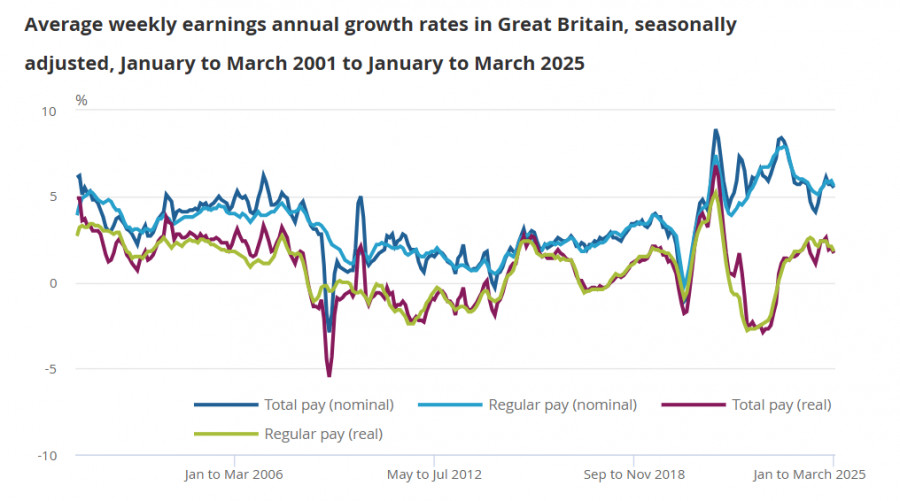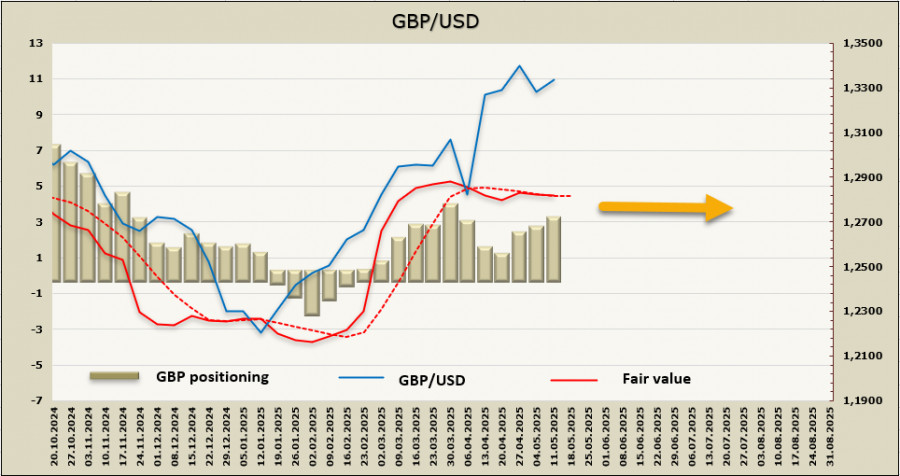See also


 15.05.2025 12:38 AM
15.05.2025 12:38 AMThe UK labor market report showed that wage growth remains high despite a slight slowdown— the three-month average declined from 5.9% to 5.6%, and including bonuses, it decreased from 5.7% to 5.5%, which was higher than the forecast of 5.2%.
Inflation in the UK is already high and, as claimed, due to base effects, it will remain elevated for the next few months before beginning to decline. This is a bullish factor for the pound, despite the rhetoric and actions of the Bank of England, which lowered the interest rate last week from 4.5% to 4.25%. While a nearly unanimous decision and a more dovish tone were expected, the opposite happened—a split within the Monetary Policy Committee became evident, and the final statement turned out even more hawkish than the previous one. The hawkish shift came from the majority camp, where three members, including Governor Bailey, stated that the decision was finely balanced between cutting and holding.
The BoE lowered its inflation forecast for the entire projection period, ending at 1.9% in 2028, mainly reflecting lower energy prices. Of course, no one knows what energy prices will be not only in 2029 but even by the end of this year, so such a forecast holds little weight.
Markets are currently pricing in about 60 basis points in rate cuts by the end of the year, less than what is expected for the Federal Reserve, which is overall more bullish than neutral for the pound. However, this forecast assumes inflation will indeed slow down, and it's clear that as long as wage growth remains high, expectations of price declines may continue to be delayed.
BoE Chief Economist Huw Pill stated on Tuesday that he is concerned UK inflation may prove stronger than the central bank expects, and that interest rates may need to remain higher than markets currently anticipate.
The net long position on the pound rose by £435 million over the reporting week to £2.44 billion. Speculative positioning is bullish, but the fair value estimate has lost momentum and lacks clear direction.
The GBP/USD pair has held above the support zone at 1.3100/30, which, from a technical standpoint, suggests a good likelihood of a resumption of upward movement. However, there is currently no clear driver. The price has fully priced in the expectation of future BoE actions and inflation. New data will likely drive the pound out of its range. On Thursday, GDP data for Q1 and March industrial production will be published, followed by the April inflation report next week. These releases are expected to provide insight into the future direction of the pound, especially since high inflation will continue to be a factor for at least a few more months. We are now observing consolidation and range-bound trading between 1.3150 and 1.3400.
You have already liked this post today
*The market analysis posted here is meant to increase your awareness, but not to give instructions to make a trade.


